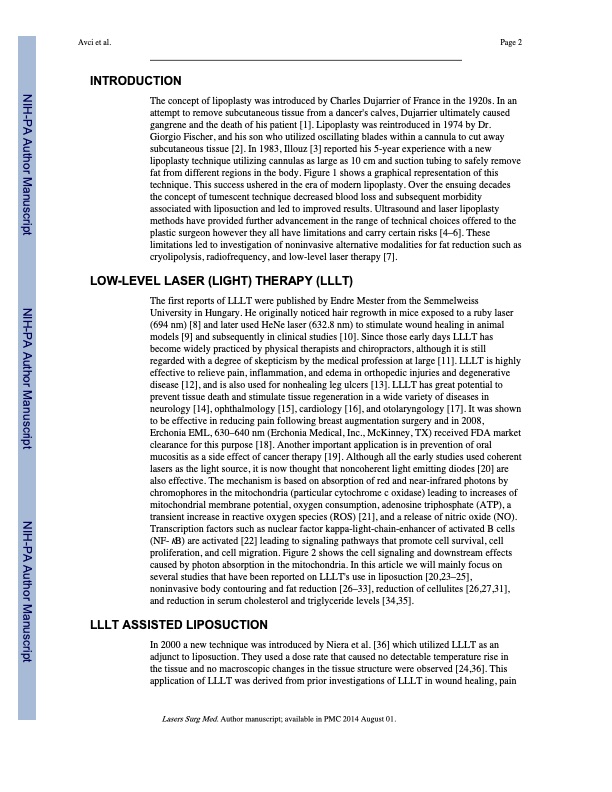
PDF Publication Title:
Text from PDF Page: 002
Avci et al. Page 2 INTRODUCTION The concept of lipoplasty was introduced by Charles Dujarrier of France in the 1920s. In an attempt to remove subcutaneous tissue from a dancer's calves, Dujarrier ultimately caused gangrene and the death of his patient [1]. Lipoplasty was reintroduced in 1974 by Dr. Giorgio Fischer, and his son who utilized oscillating blades within a cannula to cut away subcutaneous tissue [2]. In 1983, Illouz [3] reported his 5-year experience with a new lipoplasty technique utilizing cannulas as large as 10 cm and suction tubing to safely remove fat from different regions in the body. Figure 1 shows a graphical representation of this technique. This success ushered in the era of modern lipoplasty. Over the ensuing decades the concept of tumescent technique decreased blood loss and subsequent morbidity associated with liposuction and led to improved results. Ultrasound and laser lipoplasty methods have provided further advancement in the range of technical choices offered to the plastic surgeon however they all have limitations and carry certain risks [4–6]. These limitations led to investigation of noninvasive alternative modalities for fat reduction such as cryolipolysis, radiofrequency, and low-level laser therapy [7]. LOW-LEVEL LASER (LIGHT) THERAPY (LLLT) The first reports of LLLT were published by Endre Mester from the Semmelweiss University in Hungary. He originally noticed hair regrowth in mice exposed to a ruby laser (694 nm) [8] and later used HeNe laser (632.8 nm) to stimulate wound healing in animal models [9] and subsequently in clinical studies [10]. Since those early days LLLT has become widely practiced by physical therapists and chiropractors, although it is still regarded with a degree of skepticism by the medical profession at large [11]. LLLT is highly effective to relieve pain, inflammation, and edema in orthopedic injuries and degenerative disease [12], and is also used for nonhealing leg ulcers [13]. LLLT has great potential to prevent tissue death and stimulate tissue regeneration in a wide variety of diseases in neurology [14], ophthalmology [15], cardiology [16], and otolaryngology [17]. It was shown to be effective in reducing pain following breast augmentation surgery and in 2008, Erchonia EML, 630–640 nm (Erchonia Medical, Inc., McKinney, TX) received FDA market clearance for this purpose [18]. Another important application is in prevention of oral mucositis as a side effect of cancer therapy [19]. Although all the early studies used coherent lasers as the light source, it is now thought that noncoherent light emitting diodes [20] are also effective. The mechanism is based on absorption of red and near-infrared photons by chromophores in the mitochondria (particular cytochrome c oxidase) leading to increases of mitochondrial membrane potential, oxygen consumption, adenosine triphosphate (ATP), a transient increase in reactive oxygen species (ROS) [21], and a release of nitric oxide (NO). Transcription factors such as nuclear factor kappa-light-chain-enhancer of activated B cells (NF-κB) are activated [22] leading to signaling pathways that promote cell survival, cell proliferation, and cell migration. Figure 2 shows the cell signaling and downstream effects caused by photon absorption in the mitochondria. In this article we will mainly focus on several studies that have been reported on LLLT's use in liposuction [20,23–25], noninvasive body contouring and fat reduction [26–33], reduction of cellulites [26,27,31], and reduction in serum cholesterol and triglyceride levels [34,35]. LLLT ASSISTED LIPOSUCTION In 2000 a new technique was introduced by Niera et al. [36] which utilized LLLT as an adjunct to liposuction. They used a dose rate that caused no detectable temperature rise in the tissue and no macroscopic changes in the tissue structure were observed [24,36]. This application of LLLT was derived from prior investigations of LLLT in wound healing, pain Lasers Surg Med. Author manuscript; available in PMC 2014 August 01. NIH-PA Author Manuscript NIH-PA Author Manuscript NIH-PA Author ManuscriptPDF Image | Low-Level Laser Therapy for Fat Layer Reduction

PDF Search Title:
Low-Level Laser Therapy for Fat Layer ReductionOriginal File Name Searched:
nihms-509305.pdfDIY PDF Search: Google It | Yahoo | Bing
Cruise Ship Reviews | Luxury Resort | Jet | Yacht | and Travel Tech More Info
Cruising Review Topics and Articles More Info
Software based on Filemaker for the travel industry More Info
The Burgenstock Resort: Reviews on CruisingReview website... More Info
Resort Reviews: World Class resorts... More Info
The Riffelalp Resort: Reviews on CruisingReview website... More Info
| CONTACT TEL: 608-238-6001 Email: greg@cruisingreview.com | RSS | AMP |